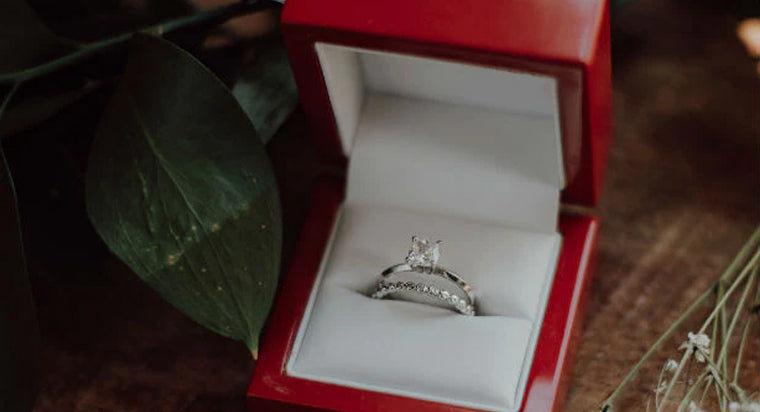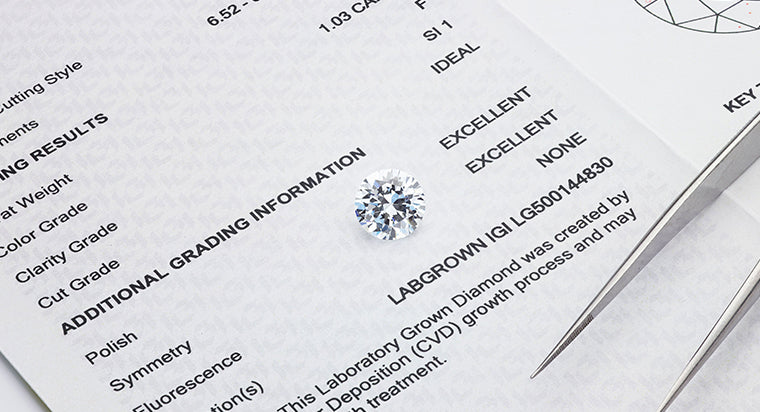What is a Diamond Girdle?
Diamonds are very popular and are worn by women and worn by men all over the world, so it is very important to understand the different characteristics and factors that affects diamonds and their quality. The diamond's girdle is the part of a diamond that separates the crown (top) from the pavilion (bottom). All diamonds have a girdle. The girdle typically varies in size and style. The girdle is graded and can be found on the diamond certification report.
TABLE OF CONTENTS
Why Are Diamond Girdles Important?
It is a contributing factor in a diamond's cut grade. The girdle is where the diamond is set and held securely in place in a piece of jewelry. The girdle reduces the risk of damage on the diamond when jewelers work with it. A standard round diamond has 16 "valley" and 16 "hill" positions, where the girdle rises and falls. Girdle thickness is reported as a range of thick to thin. Girdles can be rough (unpolished), polish (unfaceted) or polished and faceted. Today, it is common for modern girdles to be polished and faceted. In some fancy shapes such as Emerald cuts and Asscher cuts, girdles are polished but not faceted.
Girdle Scale

Like other diamond attributes, the girdle also has a grading scale. The girdle is graded by evaluating that center portion in a profile view at 10x magnification. The girdle's grade is the largest and smallest part of the girdle size. Girdles are typically not perfectly even around the diamond, thus they are given 2 grades. Below is an explanation of each of the different types of girdles.
Extremely Thin: The girdle is very, very small, almost not visible. It may be susceptible to chipping or breaking. It will have a significant impact on the cut grade of the diamond. Diamond depth may be shallow.
Very Thin: The girdle is thin and care is required when setting the diamond as risk remains of chipping it. A Very Thin girdle grade cannot result in an excellent cut grade. Diamond depth may be shallow.
Medium: A perfect girdle is seen. The risk of chipping is minimal and the cut grade is not adversely affected. The diamond's depth is not too depth as a result of the girdle. There are also combinations such as thin - medium.
Slightly Thick: The girdle is near perfect. The risk of chipping is minimal and the cut grade is not adversely affected. The diamond's depth is not too depth as a result of the girdle.
Thick: The girdle is thicker than desirable. It can very slightly increase the diamond's depth and will often result in a Very Good cut grade.
Very Thick: The girdle is much thicker than desired. It will often yield high depth and reduce the cut grade to Very Good or Good. It is possible that the girdle's reflection may be seen within the diamond.
Extremely Thick: The girdle is much thicker than recommended. It can affect the diamond's symmetry and will reduce the cut grade to Good or Fair. It will almost surely result in a "fisheye" effect, where a reflection of the girdle will be visible in the diamond. This has an adverse affect on diamond sparkle.
How is Girdle Graded
Girdle grade is assigned by looking at the thickest and thinnest aspects aspects of the diamond girdle. Girdle is graded by looking at the diamond through an optical measuring device or microscope. The measurements can be shown as a percentage relative to the average diameter of the diamond. However, the final grade is assigned by visually looking at the girdle and it's shaping. Girdle is viewed both faceup and at an angle to determine the grade.
Girdle's Effect on a Diamond
The Ideal Girdle for Round Diamonds
In a round cut diamond, the girdle will require more consideration as it has a direct impact on the cut grade of the diamond. In fancy shapes, however, the girdle often has little impact and does not require much consideration. The ideal range for a girdle is Medium - Slightly Thick in round cut diamonds. These diamonds are perfectly cut and proportionate. The diamond sparkle is not affected. In fancy shapes, it is Thin - Thick. If the girdle is completely uneven (for example, Extremely Thin to Extremely Thick), the diamond's symmetry will be disproportionate and adversely affected.
Why Very Small and Extremely Thick Girdles are Not Favorable for Diamonds
With very small girdles, the largest concern is breakage or chipping during the diamond setting process. The girdle hold the diamond securely in place in jewelry. Because heat and pressure are applied in the setting process, an extremely thin girdle can chip the diamond. On the other side, an extremely thick girdle may mean too much carat weight is trapped in the center of the diamond and so the depth is too much. This will mean the diamond will look smaller than its carat weight and the girdle may create gray reflections in the diamond, which will reduce the diamond's brilliance and make it visually duller. Fancy shaped diamonds tend to have thicker girdles, especially cushion cut diamonds. It is thickest at the corners. For step cuts and princess cuts, thicker girdles are common, but usually on one or two sides. It is used as a means of clarity exclusion and weight preservation. Thickening it reduced rough diamond wastage, which can increase the diamond value due to higher carat weight. To identify the size, it is graded from the largest or thickest point and the thinnest point.
You'll often find that gemstones such as rubies, emeralds and sapphires also have very thick girdles.
Girdle Types
Unpolished Girdle: Less common in today's diamonds, unpolished girdles have rough skin and are not recommended for optimal girdle light performance.
Polished Girdle: Typically found on step cuts and princess cut diamonds due to larger, open faceting styles. Also can be found on round diamonds. They are acceptable for light performance.
Faceted Girdle: The best and most popular with today's diamond cutters is a faceted girdle that helps maximize diamond light performance and sparkle. The most recommended style of girdle.
FAQs
What is the girdle of a diamond?
Do all diamonds have girdle reflection?
How does girdle affect a diamond?
The girdle of a diamond affects its appearance, durability, and value in the following ways:
- Appearance: The size, shape, and thickness of the girdle can impact the appearance of a diamond. A thicker girdle can make a diamond look smaller, while a thin girdle can make it appear larger.
- Durability: A thin girdle makes a diamond more vulnerable to damage, as it is more prone to chipping or breaking. A thicker girdle provides more protection and makes the diamond more durable.
- Value: The size, shape, and thickness of the girdle can impact the value of a diamond. A thicker girdle is usually preferred because it offers greater durability, while a thin girdle can lower the value of the diamond.
Overall, the girdle is an important aspect to consider when evaluating the quality of a diamond.







